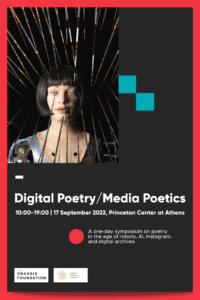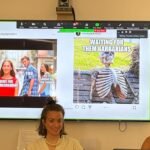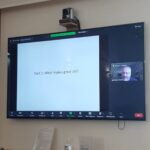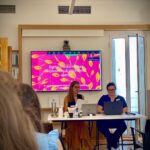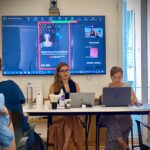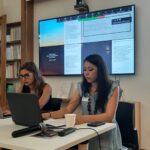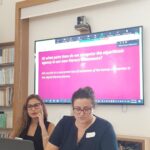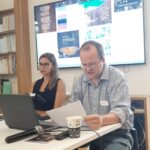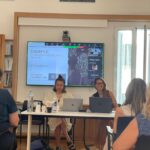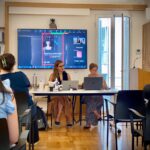Summary of the Research Proposal
This project concerns the new modalities of engagement with poetry in the digital era. On the one hand, the genre of ‘digital poetry’, which has emerged from audiovisual and textual convergence, brevity, and instant connectivity on social media, has refocused attention on poetic forms, greatly increasing poetry sales amongst young generations. On the other hand, artificial intelligence has been employed to craft poetry or poetic responses, challenging the boundaries between human creativity and algorithmically produced art. Despite the attention paid to these phenomena, the ways in which established authors and their work have become reconfigured in these expansive digital environments remains an underexplored topic. This project will employ the digital afterlives of the Greek-Alexandrian poet C.P. Cavafy, the most celebrated poet to have written in Modern Greek, as a springboard to examine the resignification of canonical poetry and short poetic forms more broadly through digital conventions.
This cross-disciplinary endeavor brings together literary studies and digital media theory. It locates in the case study of Cavafy’s multimodal presence online a singular opportunity to analyse how digital tools and platforms have transcended poetry’s print boundaries, by appropriating, fragmenting, and remodelling works traditionally encountered in print form. The case study will serve to extrapolate toward the broader cultural changes that flow of information and user agency introduce for literary posterity. For example, so far, critical theory has scrutinized the world canon for its Western and exclusionary constitution. But what does it mean for an artist’s worldwide reputation to become untethered from cultural authorities and sustained through practices that are geo-expansive and inclusive of a multiplicity of voices, ideologies and identities? How, and to what effect, does this user-led and participatory engagement with poetry speak to audiences’ needs and habits? This project will seek answers to these questions through the critical analysis of the digital environments that frame literary reputation. It will also trace how digital platforms themselves, and the opportunities they offer for engagement with poetry, shape users’ overall online activity, preferences, and interactions.
By collecting and critically analyzing a breadth of material drawn from social media, journalism, and Cavafy’s digitized archive this study will take a twofold approach: first, it will delve into the ways in which distinctive features of Cavafy’s poetry and personality have been remediated online as part of broader discussions about the transformation of literature in digital landscapes; second, it will use the poet’s example as a window into digital tools and their power to reconfigure audiences’ contact with poetry. Methods to update contemporary teaching practices are also proposed, as a way to best address a generation of users that has naturalized the ecosystem and culture of connective media. Alongside the organization of a conference on Digital Poetry, this project will include education workshops aimed at university students and educators. It will also create a website aimed to assist educators with the development of methodologies that combine the teaching of poetry with awareness of new media practices.
Digital Poetry/Media Poetics
Saturday 17th September 2022
10:00-19:00, The Princeton Center of Athens, Timarchou 3, Pagkrati, Athens
This Symposium is part of the project “The Digital Afterlives of Great Poets; The Case Study of C.P. Cavafy” supported by the Research Centre for the Humanities (RCH) for the year 2022.
It is supported by the Onassis Foundation under the Special Grant & Support Programme for Scholars’ Association members.
Please book on Eventbrite for IN PERSON ATTENDANCE or join online on Zoom: https://princeton.zoom.us/j/95622656481
10:00-10:30 Welcome and Coffee
10:30-10:45 “New Digital Lives/Afterlives”
Welcome by Foteini Dimirouli, Research Centre for the Humanities Scholar and Onassis Scholar
Welcome by Kalliroe Linardou, RCH Board Member, Athens School of Fine Art
10:45-11:30 Keynote 1 “Digital Poetics: Human Expressivity and Algorithmic Agency”,
Jeneen Naji, Maynooth University
11:30-12:45 Panel 1: The Rise of Digital Poetics
- “Hashtag Nature Poem: Reading Instapoetry as Anthropocentric Art Form”,
James MacKay, European University Cyprus - “Tag-Bait: How Instapoets Promote Posts through Poe(t/m)-tagging”,
Jueunhae Knox, AHRC, University of Glasgow, University of Sheffield - “Who are your muses?”: Authorship and Performativity in AI Poetry Generation”,
Ioanna Zouli, National and Kapodistrian University of Athens - “Born-Digital Archives and the Future Literary”,
Anna Maria Sichani, School of Advanced Study, University of London
12:45-13:15 Q&A
13:15-14:15 Lunch Break
14:30-15:15 Keynote 2 “Ai-Da: How we made the world’s first ultra-realistic humanoid AI robot artist”, Aidan Meller, Oxford
15:15-16:30 Panel 2: Rethinking Authority: Cavafy Digital
- “Cavaf-e: A Case Study in Social Media Pedagogy”,
Foteini Dimirouli, postdoctoral researcher, Research Centre for the Humanities Scholar and Onassis Scholar - “Unlocking the Cavafy Archive: People – Images – Stories. A new digital education project”, Aggeliki Mousiou, Cavafy Archive | Onassis Foundation and Sophia Zisimopoulou, The Athens Fine Art School
- “Listening to the Cavafy ‘Dionysos’ recordings: Historicising Performance Traditions through Digital Tools”,
Fiona Antonelaki, University of Thessaly
16:30-17:00 Q&A
17:00-17:30 Coffee Break
17:30-18:30 Roundtable Discussion
18:30-19:00 Final Comments and Close
Symposium Programme (PDF, PNG)
Research: The Digital Afterlives of Great Poets: The Case of C.P. Cavafy
Researcher: Dr. Foteini Dimirouli
The research project “The Digital Afterlives of Great Poets: The Case of C.P. Cavafy” was funded by the Research Centre for the Humanities (RCH) for the year 2022.
Summary
The present study, entitled “The Digital Afterlives of Great Poets: The Case Study of C.P. Cavafy” set out to accomplish a dual goal. Firstly, it set out to survey the multimodal presence of the most globally celebrated modern Greek poet, C.P. Cavafy, on digital platforms. While this aspect of the study was focused on Cavafy’s example, it also aimed to address a more wide-reaching reality: the refashioning of literary authority in digital environments, and what remediation tells us about new audience engagement with famous authors, and with poetry more generally.
Secondly, the study set out to think about the various ways in which the digital adoption of Cavafy’s poetry and persona can form the basis for new teaching methods in higher education. It took a hands-on approach to its educational hypothesis, by applying its thesis in classroom settings. Once more, this part of the study was not limited to Cavafy; rather, it also aimed to provide suggestions to educators interested in bringing the digital realm into the classroom as a means for better achieving their educational goals— in terms of students’ critical engagement with poetry, but also with new media and its uses.
The study also expanded into the broader area of digital humanities. It coincided with major developments in AI and poetry writing, first with the release of GPT-3 and then with ChatGPT. As a result, the one-day symposium organised as part of this research in September 2022 aimed to shed light on the meeting point between technology and poetics and was entitled Digital Poetry/Media Poetics. It was composed of the two panels. The first panel invited contributions from academics, entrepreneurs, artists, and practitioners working on the intersection between poetic writing and digital evolution. The second panel was dedicated more specifically to case-study of this research, by hosting contributors working on recent events in Cavafy’s digital afterlife. The event was interdisciplinary, accessible and wide-reaching and its format was hybrid (in person and online).
Surveying the Poet’s Presence Online
This first part of this study surveyed and collected material pertaining to Cavafy from Twitter, Instagram, Facebook, as well as from various online journalism platforms. The material was collected through google engine searches, but also with the assistance of appropriate microsyntax (eg. hashtags) on social media, to reveal a proliferation of content relevant to the poet. The type of this content was dictated by the conventions and business model employed by each platform, as the examples following will help illustrate.
On Instagram, a platform based on image sharing and favoured by a younger demographic (Millennials and Gen Z make up two-thirds of its base), Cavafy’s co-options take visual dimensions. To name but a few, photographs of the poet’s printed works alongside objects of everyday use, images of Cavafy-inspired graffiti on Athenian streets, images of the poet’s manuscripts (often reshared from the account of the Onassis foundation, which obtained the poet’s archive and digitalised its content[1]), images of artworks inspired by Cavafy’s portraits, poetry, and life (generated by both individual creators and as part of institutional activities, for example exhibitions with a Cavafy-inspired section), or even entirely personal photography that is linked to Cavafy through a quotation from his work serving as a caption or through relevant tags. The images are often doctored through filters and creative tools, adding unprecedented reach and variation to the poetic text, which we have been accustomed to encounter, at least traditionally, in print. At the same time, the platform itself has had an impact on the production of content that enhances Cavafy’s popularity, since the ability to instantly share it and reproduce it encourages creative approaches to the poet’s work.[2]
On Facebook, where content is more text-based, Cavafy’s verse finds its way in user posts or group posts that consist predominantly of text, or of a combination of text and image. There are a number of pages dedicated to the poet and his work.[3] On this platform the expression of opinion is commonplace, and therefore user entries are more discursively elaborate compared to Instagram. As a result, Cavafy’s poetry can be found in contexts that rest on language play for the effect, for example when lines that are particularly popular and recognisable are employed to humorous ends, as a parody of matters unrelated to poetry.
On Twitter, brevity of form —with a cap of 280 characters per tweet— encourages the fragmentation of the poetic whole, with Cavafy’s one-liners and extracted verse being converted into tweets to be retweeted by others with similar interests. There are Twitter handles dedicated to the poet’s work, @CCavafy and @cavafybot, where updates are regularly tweeted and retweeted by those “following” the poet.
Online journalism has often appealed to Cavafy’s monumentalised status and widely known corpus of poetry to create allusions or metaphors that assist reportage on current issues.[4] These texts often take heed of the more philosophical or even didactic dimensions of the poet’s work to build an argument. Such instances range from commentary on the Greek financial crisis and its culprits, to enlisting Cavafy’s poetic voice as a form of wise counsel,[5] or, more recently, as a conduit to speak of the trials of enclosure brought about by covid.[6] On one occasion, a journalist emulated Cavafy’s “Waiting for the Barbarians” to compose the poem “Waiting for Boris”, which served as a parody of Boris Johnson’s election as prime minister of the UK.[7]
Conclusion: The survey of this content tangibly showed how social media and online journalism endow poetry with new relevance. Access to verse online, as well as sharing practices across platforms, have led to the emergence of new poet-celebrities,[8] while also boosting printed poetry book sales.[9] While Cavafy was already an accepted authority in the traditional sense, with his work taught in Greek schools from the 1960s to the present day, and his genius revered by experts and critics since the early 20th century, the popularisation and democratisation of his image is being critically enhanced by digital media. With a vast following on the three most popular social media platforms, and a steady inclusion in more or less erudite forms of news coverage and reportage, Cavafy has become even more widely recognisable both locally and globally. According to Google trends analytics, his popularity in terms of clicks and searches by far surpasses that of any other Greek poet, both in Greece and abroad.[10]
It also became apparent that the poet’s online uses were heavily dictated by the functionality of each platform, therefore encouraging creative adjustments of poetry to dominant media conventions. Whether it is photographs, doctored and user-created images, captions, status updates, or tweets, it becomes clear that poetry is now finding its way into non-printed versions that are dependent upon the connective capacities and user interaction functionality of each medium. In turn, this appropriative framework serves to turn attention to Cavafy’s figure in less controlled environments, which are dominated by self-expression rather than academic rigor, therefore expanding the resonance of a poetic corpus so far reserved for more select audiences.
A dominant effect that appears to go hand-in-hand with the remediation of poetry is fragmentation. While sometimes Cavafy’s poems appear in their entirety, this is not always the case. Often only a couple of lines will be converted into taglines, captions, or tweets, meaning that a readership’s relationship with the poetic whole, and even with reading itself, is altered. Poems are recast in more condensed and shareable forms, albeit a significant part of their effect might be lost in the process.[11]
Application in Teaching
The pedagogical dimension of this study was premised upon a variety of research findings. Firstly, research into different forms of media intensity amongst young people suggests that active social media engagement, as opposed to passive observation (known as “lurking”), can be a positive force, which encourages identity expression and creativity.[12] Secondly, research findings suggest that attention is in short supply amongst younger generations.[13] Digital media and the modes of reading and engagement that they introduce (eye-catching effect, digestible and brief content) are implicated in this reality. They also encourage addictive tendencies amongst users. Instructors are facing unprecedented challenges in convincing students to read dense text, or to “put [their] phone away”. Since prohibition rarely yields the desired results, instructors should aim to include digital media in a meaningful way within the lesson plan. For example, this study suggests, by incentivising students to “take their phone out” as part of a guided research and teaching plan. After all, as Helen Gregory argues, “young people were busy creating and disseminating digital art and forging online identities at the same time as while many of us (teachers, scholars and poets) were still debating what digital literacy meant”[14]. At the same time, it is important for such a pedagogical experiment to introduce students to critical debates on social media and to a better understanding of the business models and financial incentives that undergird them, especially when dealing with a generation of social media users that have naturalized “the ecosystem of connective media”.[15]
Some examples of higher education classroom and workshop activities relating to Cavafy will help illustrate the ways in which the research was applied in the classroom, and what the results were. Broadly speaking, activities consisted of three steps. First, a student-led step which included observation, research, and collection of material about Cavafy from digital platforms. As part of this, students were asked to identify instances of Cavafy’s co-option online, and to share them on an online class group before our meeting or, in workshops, in real time. Second, an instructor-led step which converted this material into an occasion to guide students to read poetry thoroughly and thoughtfully, with an emphasis on close reading and analysis. Third, an interactive step, which consisted of reviewing the two previous steps in the classroom, by discussing the relationship between the digital use and the original, as well as the influence of the medium itself on this relationship. To illustrate this method, I will present four examples below. It should be noted that these examples serve as a guide. They are indicative of the nature of the lesson plan, but do not capture the breadth of projects, discussions, and written assignments undertaken.
A number of students found evidence on Instagram of an international art exhibition called Portals, and organised by NEON,[16] which was taking place in Athens at the time of instruction. The opening act of the exhibition featured nine different translated renditions of the final lines of Cavafy’s “Waiting for the Barbarians” «και τώρα τι θα γένουμε χωρίς βαρβάρους./Οι άνθρωποι αυτοί ήταν μια κάποια λύσις.»[17] The visual effect was gripping, with the nine versions presented in neon lighting at the very entrance, in the form of an installation framed by a large stone arch. Visitors were inclined to photograph the installation and upload images on Instagram, tagging #cavafy in the caption. The exhibition was highly popular, which meant that a large proportion of the students came across it and documented it on the online class journal (blackboard) where they posted their findings before class.
Once the event was identified, we decided to visit the site on a class trip. Knowing that “Waiting for the Barbarians” was the subject of the opening exhibit, we first read and discussed the poem at length in class.
During the visit, students were asked to photograph the nine translated renditions of the last stanza on the wall, and to select two versions per group (each group consisted of 2-3 students) and compare them against each other during short class presentations. This exercise proved to be immensely fruitful for poem analysis. Different versions, by taking divergent approaches to details —which might appear small but significantly alter meaning— became a channel for classroom debate. This debate also cast a different light on our initial reading of the poem, undertaken prior to the visit. For example, we compared “What are we going to do now/without the barbarians?/In a way, those people were a solution.” against “And now what’s to become of us without barbarians./Those people were a solution of a sort.” Notice how translating differences reframe the entire message of the poem. For example, the first version replaces Cavafy’s full-stop in the first line of the Greek original with a question mark (something which almost every mainstream translation of the poem in English also does), in this way creating a neat pattern with the rest of the poem, which is in question-answer form. But it is possible —indeed, likely— that Cavafy intended the last stanza to have a disruptive effect. If he did, why would that be? Moreover, the first translation includes the definite article, “without the barbarians”, which mirrors the poem’s title, whereas the second erases it “without barbarians”. We compared these effects to the Greek original and discussed whether keeping or omitting the definite article impacts the universalising effect of what Cavafy is trying to say, and our interpretation of who the barbarians might be. The exercise also offered the opportunity to use the fragmented stanza as a way to return to the entire poem more creatively, and to observe in a tangible way how investigating the relationship between the two might inspire unexpected readings. It should to be noted that the students involved in this exercise were able to read both Greek and English. Adjustments may need to be made for different student audiences.
After discussing the details of the poem, we spent some time reflecting on the reasons why somebody might post an image of themselves in front of Cavafy’s verse at an exhibition. How is reading implicated in this action? What is the meeting point between art and poetry? Is the documentation of one’s life and activities online important in terms of identity building and self-expression? This final step aimed to increase media awareness, and to lead students to think about changes that social media have brought about in terms of self-representation. Critical material was handed out to assist students in their understanding of these issues.[18]
The second event that students spotted, also on Instagram through #cavafy, was the opening of a “Cavafy bar” in the Imaret hotel in Kavala. The bar’s decoration is inspired by Cavafy, with rare etchings, sketches and portraits of the poet hanging on the walls. I asked my students to reflect upon why a bar would make Cavafy the protagonist of its marketing plan, after introducing them to some theory around the socialised spaces (bars and cafes)[19] that often appear in Cavafy’s poetry and their links to the constitution of gay identity. The next class assignment required that they identify poems that showcase this link, and that they write and submit a commentary about them as homework. The most commonly identified poem was “Half an Hour” (Μισή Ώρα) from the Unfinished Poems, which we then read and analysed together in class. This was a good way to encourage students to look beyond Cavafy’s micro-canon, meaning his most widely known poems. During this process my role as instructor was to guide close reading and analysis with the assistance of a large projector screen but also to interject in class discussion by providing some additional context about 20th century Alexandria and Cavafy’s biography. The discussion also addressed the commodification of poetry and its material applications, including whether a poet can become a brand name and how this might affect our perception of the work.
A third example was when a student submitted a post from Twitter, where @C.P. Cavafy interacted with @LawrenceDurrellSociety. The exchange included the poems “Ithaca” and “The City”. The two poems were brought forward for analysis in class, and a comparison between the two focused on how the former introduces themes of adventure and discovery whereas the latter themes of enclosure and stagnation. Additionally, “The City” is composed of two stanzas, the first of which represents, according to Anthony Hirst, the “escapist voice” where the narrator seeks to escape reality, and the second the “realist” voices which acts as a reminder that all act of escape is in vain.[20] We paid careful attention to the essence of these conflicts by reading the poems line by line in class. I then asked the student who originally uploaded the Twitter interaction to do some research on why the two handles (Cavafy and Durrell) might be interacting with each other, and to present their findings in the next class. The students did not (yet) know that Lawrence Durrell lived in Alexandria a decade after the poet’s death, and immortalised Cavafy as a haunting figure (referred to as the city’s Poet) in his modernist magnum opus The Alexandria Quartet. Another student picked up the link between Cavafy and the famous artist David Hockney in a similar way on Twitter and was asked to present research findings on their relationship. For context, fourteen etchings made by Hockney and inspired by Cavafy poems were published in 1966, an event which cemented a longstanding association between poet and artist.
The student presentations ignited discussion on issues of intertextuality, influence, and literary exchange, with the assistance of some theoretical context that I provided on these matters. We reflected upon how new media might sustain literary relationships and networks after those concerned are dead, and how one person’s status and recognition might reflect on another. I added some information pertinent to Cavafy, Durrell, and Hockney through short interjections, but the student research presentations themselves were successful in mediating relevant content and encouraging discussion.
Another assignment (the final one) was creative. Having now surveyed content relevant to Cavafy from multiple angles, and having thought about social media in some depth, students were asked to create their own posts based on Cavafy’s poetry on a class Instagram handle created for this purpose. Students were encouraged to post absolutely anything, as long as the post was then presented in class alongside the rationale that led to its creation and the intention behind it. The results were as imaginative and varied as the content the students had surveyed so far. A student uploaded an image from her personal life, captioned by a Cavafian line about memory and the past; another student created humorous memes based on Cavafy’s “Waiting for the Barbarians” and “Since Nine O’clock”; somebody else used Cavafy’s verse to raise awareness for international special needs day. The presentations were colourful and inspired, exhibiting not only a good understanding of the poetic work, but also an awareness of the medium, and of the reasoning behind its use.
Conclusion: The integration of new media into the teaching framework of this study was found to assist textual analysis, critical thinking skills and creativity within the classroom; additionally, students’ contact with poetry in non-traditional contexts, familiar to them from other aspects of their everyday lives, opened up routes for creative interpretation, prompted them to participate more actively in discussion and, ultimately, made learning and reading poetry more fun (the latter being particularly important for the teaching of a literary genre often thought of as “difficult” among younger generations). Additionally, the focus on different forms of media engagement and their underlying benefits and pitfalls urged students to be more mindful of the nature of their digital activity outside the classroom. An interesting phenomenon, which had not been anticipated, also came to the surface. The function of algorithms to pick up trends and patterns, to promote content that is of interest to users, or to bring together users with shared interests (also known as “grouping”) assisted the goals of this class. Students found that by using their personal accounts for research, they received page and profile recommendations related to poetry. At the same time, their feeds now included literary posts and reels, which (they reported) enhanced their exposure to poetry, making them more likely to read it, as well as their familiarity with Cavafy’s verse.
The anonymous student feedback submitted at the end of the course suggested that the students enjoyed the class. In the feedback form for the seminar class “Cavafy in Digital Spaces” the highest score was 4.91/5 and the lowest 4.36/5. A positive outcome is considered to be an average of 3.5/5 and above, which this class by far surpassed. Some selected comments from the student feedback form:
——
Student 1: “The instructor’s way of teaching, knowledge and enthusiasm was very helpful in order to learn the subject and have fun at the same time. Her guidance was also very helpful in the projects. In short, the course would not be the same if we did not have this instructor I believe.”
Student 2: “The fact that we analysed poems during class made me want to start reading more poetry. Moreover it was really interesting that we were having discussions about poems.”
——
The positive outcome of this class led me to compose the paper “Cavafy-e: A Case Study in Social Media Pedagogy”, which I presented at the symposium Digital Poetry/Media Poetics that I organised as part of this research.
Additionally, I finalised the chapter “Cavafy Digital: Teaching Poetry through Connective Media,” to be published in 2023 in Teaching Cavafy, MLA Approaches to Teaching series, eds. Peter Jeffreys and Dimitris Tryphonopoulos, MLA.
A website is currently under construction, which will showcase the research materials presented here in a systematised way accompanied by images. The domain has been secured for cavafydigital.com and its different sections mirror the results of this study. One section includes an overview of Cavafy’s remediation on social media and online journalism. Another presents this material in educational contexts and provides top tips for educators on how to integrate the material in a lesson plan. The website is bilingual (English and Greek) and I am currently securing copyrights for the images and posts that are to be included.
AI and Poetry
The ability of large language models to generate poetry came to the forefront of attention when this study was underway, with the release of GPT-3 in 2020 and ChatGPT in 2022. If it was once unthinkable that we would be reading machine-generated poetry, pre-trained generative transformers have rendered the notion commonplace by producing human-like writings that are indiscernible from their human counterparts. This happens through the input of prompts that generate infinite outputs.[2] As an example, a prompt could read like the following: “Write a poem in Shakespearean style that speaks of love and devotion and makes reference to a star and a fox.” Infinite results can be produced on the basis of such a prompt, and each one can be tweaked through the addition of further prompts, for example: “Rewrite as a rhymed modern poem.” My research into this area led to the expansion of the subject of the one-day international conference organised as part of this study. Digital Poetry/Media Poetics extended beyond the refashioning of the poetic authority of C.P. Cavafy to include reflections on the poetic category vis-à-vis the rise of digital tools and artificial intelligence. The presenters touched upon several topics, ranging from AI generated works, to the path-breaking creation of Ai-Da (the first ultra-realistic robot artist) and the meteoric rise of Instapoetry.
Additionally, a paper I wrote about the humanistic implications of AI systems was presented at the conference The Digital Condition & Humanities Knowledge which was co-organised by RCH and ISRF. The paper is entitled “Poetry and the Limits of Consciousness: From Robopoetics to Artificial Intelligence”. It employs the case study of GPT-3 as a springboard to investigate the convergence between poetic production and artificial intelligence, as well as to think about the future of creativity at the threshold of a new era of AI dominance.[21] While some argue that we are closer than ever to being replaced by machines, even in the most nuanced of tasks, such as poetry writing, others argue that creative activities, by hosting associations drawn from human experience, reveal limits in the capacity of machines. The paper tackles this debate through a careful consideration of what we think of as human consciousness and creative novelty.
Conclusion: This part of the research project is still underway and will continue beyond the timeframe of this study. I was recently asked to be a consultant for a volume of collected poetry produced by different natural language processing systems. I help to choose and edit the poems to be included in the final publication. I am currently writing the introduction on the basis of the paper I produced for The Digital Condition conference, in which I address developments in poetry writing by thinking about poetry and digital personhood,[22] and what the future holds for human creativity. I cannot reveal specific information about this project, as I have signed an NDA.
[1] https://www.onassis.org/initiatives/cavafy-archive
[2] https://www.instagram.com/explore/tags/cavafy/?hl=en
[3] For example, https://www.facebook.com/constantinecavafypage.
[4] On this see: Mendelsohn, Daniel, “The Right Poem.” The New Yorker, 27 July 2015 and “Waiting for the Barbarians and the Government Shutdown”, The New Yorker, 1 October 2013.
[5] A Financial Times article, published in 2015, found in Cavafy’s poem “Waiting for the Barbarians” themes of decline and decay that highlighted universal concerns arising from the Greek crisis; in the journalist’s words, “the pervasive foreboding of doom depicted in Cavafy’s masterwork should serve in 2016 as a wake-up call for Europe” (Barber, “The Decline of Europe is a Global Concern”). Similarly evoking the poet to criticize the handling of the Greek crisis, in 2013 the former editor-in-chief of the German newspaper Die Zeit, Theo Sommer, quoted the poem “In a Large Greek Colony, 200 BC” in its entirety, along with its German translation, urging readers to benefit from its message about external intervention and reform (“Griechenland nach den Kürzungen-ein Gedicht”)
[6] As indicative of this trend see Nikos Konstandaras, “Remembering Cavafy in Lockdown”, Kathimerini, 25/04/2020. https://www.ekathimerini.com/opinion/252008/remembering-cavafy-in-lockdown/
[7] Kevin Higgins, “Poem: Waiting for Boris”, The Platform, 21/06/2019/
[8] The most preeminent example of this trend is Rupi Kaur, an India-born Canadian poet who started her career as a performing poet in 2009, eventually gaining millions of followers on Instagram. Her printed poetry collections were a commercial success, and she is today hailed as one of the most prominent Instapoet of her generation.
[9] Poetry sales nearly doubled from 2012 to 2018. See Sarah Crown, “Generation Next: The Rise- and Rise- of the New Poets”, The Guardian, 16/02/2019 and Donna Ferguson, “Poetry Sales Soar as Political Millenials Search for Clarity”, The Guardian, 21/01/2019.
[10] Google tends analytics help to quantify interest taken in an author, both within a country and on a worldwide scale. Google searches about Cavafy in Greece from 2015 to 2020 surpassed those about Dionysios Solomos (the country’s national poet) and George Seferis (a Nobel Prize winner). The discrepancy concerning the same set of authors is even larger when the search terms are applied to a worldwide scale, indicating the extent to which Cavafy reigns relative to other prominent Greek figures, as well as his centrality to the opening of Modern Greek literature to the global digital arena.
[11] On this issue see:
Papanikolaou Dimitris and Eleni Papargyriou, “Cavafy Pop: Popular Reception, Cultural Productivity and the Many Lives of Poems”, Journal of Greek Media & Culture, 1:2, 2015, pp. 183-190.
Dimitris Plantzos, “Perverse Fragments: Citing Cavafy in Crisis- Stricken Athens,” Journal of Greek Media&Cuture 1 (2), 2015, pp. 195–205.
[12] James A. Roberts and Meredith E. David. “The Social Media Party: Fear of Missing Out (FoMO), Social Media Intensity, Connection, and Well-Being.” International Journal of Human-Computer Interaction, Vol.36, No.4, 2020, pp. 386-392.
[13] Sherry Turkle, Reclaiming Conversation: The Power of Talk in a Digital Age. New York, Penguin, 2015, p. 213.
[14] Helen Gregory, “Youth Take the Lead: Digital Poetry and the Next Generation.” English in
Education, vol. 47, no. 2, Summer 2013, pp. 118-33, p. 122.
[15] José Van Dijck,. The Culture of Connectivity: A Critical History of Social Media. Oxford UP, 2013, p. 21.
[16] See description of the exhibition in The Financial Times: https://www.ft.com/content/6e847621-747d-4557-bf73-56dacdbe2c70.
[17] https://www.yatzer.com/portals-neon/slideshow/1
[18] A short list of assigmed critical readings:
Marshall McLuhan, Chapter 1, Understanding Media: The Extensions of Man, 1964.
José Van Dijck, “Introduction”, The Culture of Connectivity: A Critical History of Social Media (Oxford: Oxford University Press, 2013).
Bernard R.Robin and Sara G. McNeil, “Digital Storytelling” and
“Esthetics in Media Literacy” The International Encyclopedia of Media Literacy, John Wiley, 2019.
Jay David Bolter, “Remediation”, The International Encyclopedia of Communication Theory and Philosophy, John Wiley, 2016.
[19] Matthew Gumpert, “Freedom Within the Margin: The Café in the Poetry of Cavafy”, Journal of Modern Greek Studies 9:2, John Hopkins UP, October 1991, pp. 215-235.
[20] Anthony Hirst, ‘“The Old Poet of the City”: Cavafy in Darley’s Alexandria’, Deus Loci, 8 (2001-2002), 69-94, pp. 82-3.
[21] A short summary of GPT-3 and its capacities: https://medium.com/sciforce/what-is-gpt-3-how-does-it-work-and-what-does-it-actually-do-9f721d69e5c1
[22] For an introduction to the debate see Carmine Starnino, “Poetry & Digital Personhood”, The New Criterion, April 2022. https://newcriterion.com/issues/2022/4/poetry-digital-personhood
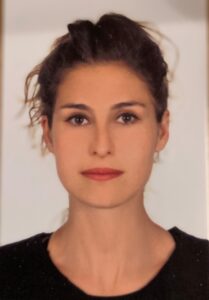 Foteini Dimirouli completed her BA and MA in English Literature (Athens University, Durham University), and her doctorate in Comparative Literature (University of Oxford). Her DPhil concerned the gradual constitution of C.P. Cavafy’s reputation on the global literary scene, as this materialized through the mediation of prominent Anglophone writers during the 20th century. Her book Authorising the Other: C.P. Cavafy in the English and American Literary Scenes is forthcoming by Oxford University Press in 2022. She was appointed postdoctoral fellow at Princeton Center for Hellenic Studies in 2017, and after that postdoctoral researcher in English and Comparative Literature (Junior Fellow) and lead of the programme for access and outreach at Keble College, Oxford.
Foteini Dimirouli completed her BA and MA in English Literature (Athens University, Durham University), and her doctorate in Comparative Literature (University of Oxford). Her DPhil concerned the gradual constitution of C.P. Cavafy’s reputation on the global literary scene, as this materialized through the mediation of prominent Anglophone writers during the 20th century. Her book Authorising the Other: C.P. Cavafy in the English and American Literary Scenes is forthcoming by Oxford University Press in 2022. She was appointed postdoctoral fellow at Princeton Center for Hellenic Studies in 2017, and after that postdoctoral researcher in English and Comparative Literature (Junior Fellow) and lead of the programme for access and outreach at Keble College, Oxford.
In her publications she has examined the production of authorial fame from a sociological perspective, as well as the question of the autonomy of the work of art in contexts of authoritarianism and censorship. Her current research focuses on the digital remediation of literature, as well as the issue of gender and otherness in translating practice. She has taught extensively in the area of 19th and 20th English, Greek, and Comparative Literature, both at an undergraduate and masters level, and has presented her research at international conferences and seminars. She is member of the Onassis Scholars’ Association and Visiting Fellow at the Hellenic Institute of the American College of Athens.

